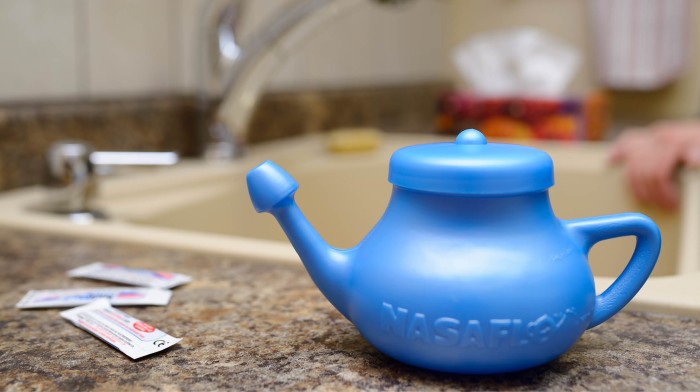
Sniffle season has arrived. Symptoms from seasonal allergies, the circulation of the common cold and other respiratory viruses can be a pain to deal with, especially around the holiday season. So what can we do to keep them at bay?
In addition to donning a facemask, regularly washing hands and getting available vaccines, sinus and nasal rinsing is among the tools a doctor may recommend to help keep you from getting sick. It can also help manage symptoms if you do.
Even if the idea of rinsing out your sinuses or nose makes you cringe, Matthew Patterson, MD, a University of Minnesota Physicians (M Physicians) ear, nose and throat specialist, has some insight for how to make it work for you.
What is sinus rinsing anyway?
“Simply put, sinus rinsing is the physical rinsing of the nose to remove pathogens and allergens from the mucosal surface, and it can prevent inflammation and infection in the nose,” Dr. Patterson explains.
By removing pathogens like viruses or bacteria, Dr. Patterson says sinus rinsing can be highly effective at preventing certain kinds of illnesses, and it can also help patients avoid allergy issues and sinus infections.
It’s most effective when used in a preventative setting, but if someone is already feeling symptoms of a cold or allergies, sinus rinsing can be helpful in managing and relieving some of those symptoms.
“It can help rinse out crusting or thick mucus that may be starting to clog nasal passages,” he says, adding, “It can also help get rid of crusted mucus that can irritate the nose and block the tubes that go into the ears.”
Dr. Patterson says that sinus and nasal rinsing can also help antibiotic therapies or other medical therapies like nasal sprays work better. Irrigating the nose before using a nasal spray can remove mucus or other materials that may keep the nasal spray from doing what it needs to do.
What to keep in mind when sinus rinsing
To get the most preventative value out of sinus rinsing, Dr. Patterson often recommends patients rinse one to four times a day. “Though for those of us on rigid schedules, four times a day can be unmanageable, but we consider once a day the minimum.”
Dr. Patterson emphasizes that it is critical to use a sterile solution like distilled water when rinsing. He says to avoid using tap water since certain bacteria or other agents can live in tap water and can sometimes lead to severe infections in the nose.
Some people may also choose to use a powered irrigator or another type that pushes material all the way up the nose and out the other side. This can irritate or cause fluid to go up the tube that connects the sinus and ear, which can make it feel like the ear is plugged.
If that happens, Dr. Patterson says that he usually recommends using a less forceful method like a bulb syringe, which are commonly used for babies. Instead of using the suction to pull the mucus out in an adult, though, Dr. Patterson explains that patients can use the syringe to simply flush some of the material out of the nose.
He also notes that it can be helpful to lean over the sink, flush the material and let it run straight out without pushing it all of the way up. Dr. Patterson says this is still effective since a majority of the bacteria and allergens get caught in the front of the nose.
Who shouldn’t use a sinus rinse?
Sinus rinsing is not for everyone, Dr. Patterson says, noting you should always check with your doctor before trying it for the first time.
“Generally, there are conditions that would keep us from recommending someone do it, like a previous nose surgery,” he explains.
Despite how quickly cold and allergy symptoms may arrive, you can help stay ahead of them by rinsing your nose and sinuses regularly. And if they do catch you by surprise, it can help you manage the symptoms as you recover too.